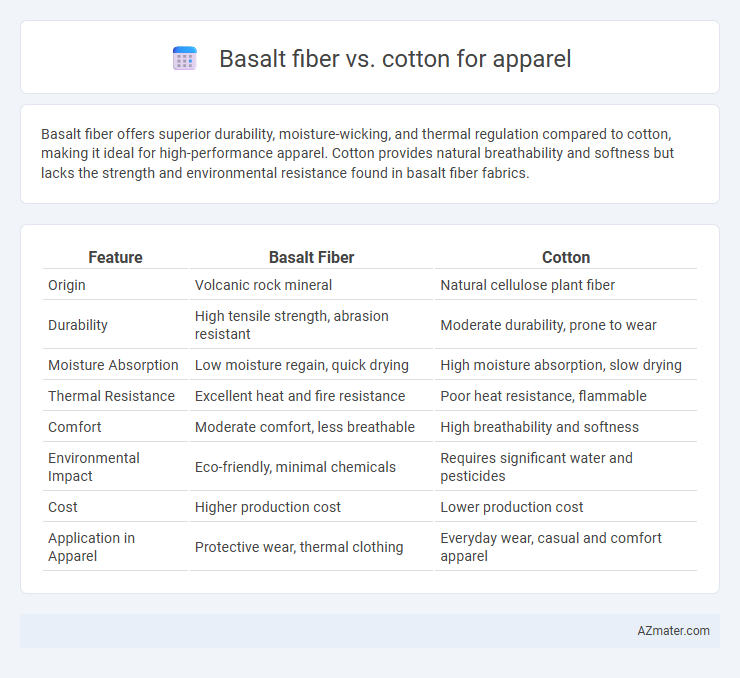Basalt fiber offers superior durability, moisture-wicking, and thermal regulation compared to cotton, making it ideal for high-performance apparel. Cotton provides natural breathability and softness but lacks the strength and environmental resistance found in basalt fiber fabrics.
Table of Comparison
| Feature | Basalt Fiber | Cotton |
|---|---|---|
| Origin | Volcanic rock mineral | Natural cellulose plant fiber |
| Durability | High tensile strength, abrasion resistant | Moderate durability, prone to wear |
| Moisture Absorption | Low moisture regain, quick drying | High moisture absorption, slow drying |
| Thermal Resistance | Excellent heat and fire resistance | Poor heat resistance, flammable |
| Comfort | Moderate comfort, less breathable | High breathability and softness |
| Environmental Impact | Eco-friendly, minimal chemicals | Requires significant water and pesticides |
| Cost | Higher production cost | Lower production cost |
| Application in Apparel | Protective wear, thermal clothing | Everyday wear, casual and comfort apparel |
Introduction to Basalt Fiber and Cotton
Basalt fiber is a natural inorganic fiber derived from volcanic rock, offering high tensile strength, excellent thermal stability, and resistance to chemical and UV degradation, making it ideal for durable and performance-oriented apparel. Cotton, a natural organic fiber from the cotton plant, is prized for its softness, breathability, moisture absorption, and comfort, commonly used in everyday clothing and textiles. Comparing basalt fiber and cotton in apparel highlights the balance between strength and durability of basalt fiber versus the comfort and versatility of cotton.
Material Composition and Origins
Basalt fiber, derived from volcanic basalt rock, offers superior strength and thermal resistance compared to cotton, which is a natural fiber harvested from the cotton plant's seed hairs. Basalt fiber's inorganic composition grants durability and resistance to moisture and UV rays, whereas cotton's cellulose-based structure provides breathability and softness. Originating from molten lava formations, basalt fiber integrates geological minerals into textiles, contrasting with cotton's agricultural roots in temperate climates worldwide.
Mechanical Strength and Durability
Basalt fiber outperforms cotton in mechanical strength, offering a tensile strength of approximately 3000 MPa compared to cotton's 400-800 MPa, making it significantly more resistant to tearing and stretching. Durability-wise, basalt fiber exhibits excellent resistance to UV radiation, chemicals, and moisture, ensuring longer-lasting apparel performance under harsh conditions. Cotton, while breathable and comfortable, tends to degrade faster with repeated washing and exposure to environmental factors, limiting its lifespan in high-stress applications.
Breathability and Comfort
Basalt fiber offers superior breathability compared to cotton due to its natural moisture-wicking properties and enhanced airflow, making it ideal for activewear and outdoor clothing. Unlike cotton, which retains moisture and can become heavy and uncomfortable when wet, basalt fiber helps regulate body temperature by allowing sweat to evaporate quickly, promoting greater comfort. The durability and thermal insulation of basalt fiber also contribute to long-lasting comfort without compromising breathability, positioning it as a high-performance alternative in apparel.
Moisture Absorption and Quick-Drying Properties
Basalt fiber exhibits significantly lower moisture absorption compared to cotton, with a moisture regain rate of about 0.5% against cotton's 7-8%, making it ideal for dry-wear applications. Its quick-drying properties stem from its hydrophobic nature, allowing moisture to evaporate rapidly and enhancing comfort in activewear and outdoor apparel. Cotton absorbs and retains moisture, leading to slower drying times and potential discomfort during prolonged wear.
Environmental Impact and Sustainability
Basalt fiber offers significant environmental advantages over cotton by requiring less water, pesticides, and land for production, reducing ecological footprint and promoting sustainable resource use. Cotton cultivation is water-intensive and heavily reliant on chemical fertilizers, often leading to soil degradation, water pollution, and biodiversity loss. Basalt fiber's durability and biodegradability contribute to longer-lasting apparel with lower waste generation, supporting circular fashion initiatives and reducing environmental impact.
Thermal Insulation and Temperature Regulation
Basalt fiber offers superior thermal insulation compared to cotton due to its high heat resistance and ability to retain warmth in cold conditions while remaining breathable in warmer environments. Cotton excels in moisture absorption but lacks the thermal regulation properties of basalt fiber, often leading to less effective temperature control during extreme weather. The mineral composition of basalt fiber enhances its capacity for maintaining consistent body temperature, making it ideal for advanced performance apparel.
Cost and Market Availability
Basalt fiber apparel typically costs 20-30% more than cotton due to its advanced manufacturing process and performance benefits like durability and thermal resistance. Cotton remains more widely available in global markets, benefiting from established supply chains and lower production expenses. Despite higher costs, basalt fiber is gaining traction in niche segments demanding enhanced strength and sustainability.
Applications in Fashion and Apparel Design
Basalt fiber offers enhanced durability, thermal resistance, and moisture-wicking properties, making it ideal for high-performance and sustainable fashion applications compared to cotton's softness and breathability. In apparel design, basalt fiber enables innovative uses in protective clothing, activewear, and eco-friendly collections due to its natural fire-retardant and antibacterial characteristics. Cotton remains preferred for everyday wear and casual garments, yet the integration of basalt fiber supports advancement in functional and technical fashion markets.
Future Trends and Innovations in Textile Industry
Basalt fiber is emerging as a sustainable, high-performance alternative to cotton in apparel due to its superior thermal resistance, durability, and eco-friendly production process. Innovations in basalt fiber composites and nano-enhanced treatments are driving its integration into smart textiles and wearable technology. The textile industry is increasingly investing in basalt fiber to meet consumer demand for sustainable, functional, and long-lasting clothing, positioning it as a future trend alongside traditional cotton.

Infographic: Basalt fiber vs Cotton for Apparel
 azmater.com
azmater.com